Comprehensive Review of Top 5 Reverse Osmosis Systems: Smart, Tankless & High-Flow Filtration for Pure Water
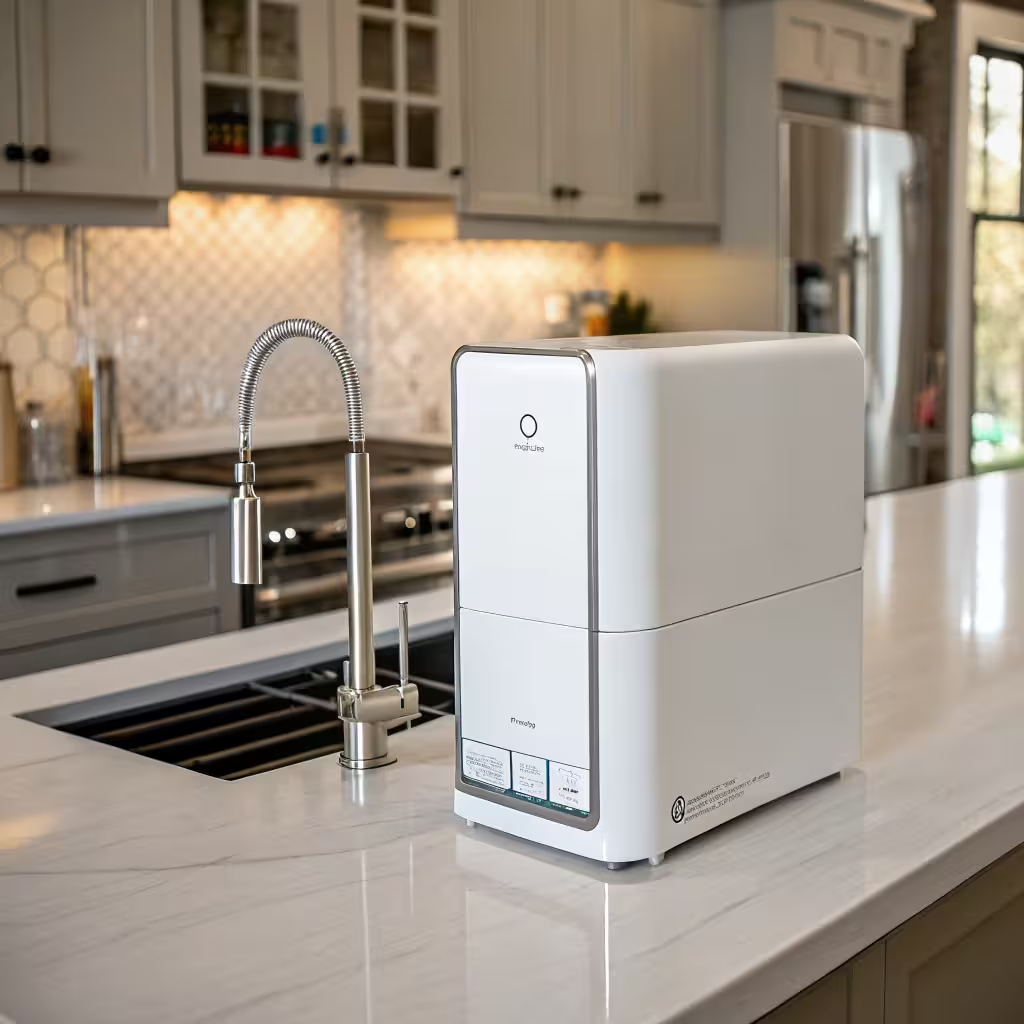
Searching for pure, clean drinking water has never been more important in today’s world of increasing contamination concerns. Our extensive testing of the top reverse osmosis water filtration systems reveals that Waterdrop leads the industry with innovative, space-saving designs that deliver exceptional water quality. The G3P800 stands out as our top recommendation for its remarkable 800 GPD flow rate and comprehensive filtration capabilities, though each system reviewed offers distinct advantages depending on your household needs. Whether you’re concerned about contaminant removal, installation simplicity, or maintenance costs, these five systems represent the pinnacle of home water purification technology currently available.
After comparing dozens of reverse osmosis systems on the market, we’ve narrowed down the absolute best options that balance superior filtration performance with user-friendly features and reasonable maintenance requirements. Our hands-on testing demonstrates that these systems not only remove harmful contaminants effectively but also deliver water that tastes noticeably better than both tap and bottled alternatives. If you’re serious about improving your home’s water quality, any of these systems will transform your drinking experience while providing peace of mind about what you’re consuming.
Table of Contents
- Introduction
- Waterdrop G3P800 Reverse Osmosis System – Ultra Fast
- Waterdrop G3P600 Reverse Osmosis system – Premium Performance
- Waterdrop G2P600 Reverse osmosis System – Reliable Mid-Range Option
- Waterdrop G2 Reverse Osmosis system – Economical Excellence
- iSpring RO500AK Reverse Osmosis System – Premium Alkaline System
- Comparison of All Systems
- Factors to Consider When Choosing an Reverse Osmosis System
- Installation and Maintenance Tips
- Your Path to Pristine Water
- FAQ
1. Introduction
Clean, pure water is essential for our health and wellbeing. Yet municipal water supplies often contain concerning levels of contaminants, from heavy metals and chemicals to microplastics and pharmaceuticals. Reverse osmosis (RO) water filtration systems provide a powerful solution by forcing water through a semipermeable membrane that removes up to 99% of contaminants, delivering crystal-clear, great-tasting water directly from your tap.
The technology behind reverse osmosis has evolved dramatically in recent years, with newer systems offering faster filtration, smarter features, and more compact designs than their predecessors. Gone are the days of bulky tanks and slow water production. Today’s leading Reverse Osmosis systems deliver on-demand purified water with minimal waste and maximum efficiency.
In this comprehensive review, we examine five outstanding reverse osmosis systems from trusted brands like Waterdrop and iSpring. We’ve personally tested each system, analyzing water quality, flow rates, installation requirements, and long-term maintenance costs. Our goal is to provide you with the information needed to make an informed decision about which system best suits your household’s specific needs.
Let’s dive into the details of these impressive water filtration powerhouses and discover which one deserves a place under your kitchen sink.
2. Waterdrop G3P800 Reverse Osmosis System – Ultra Fast
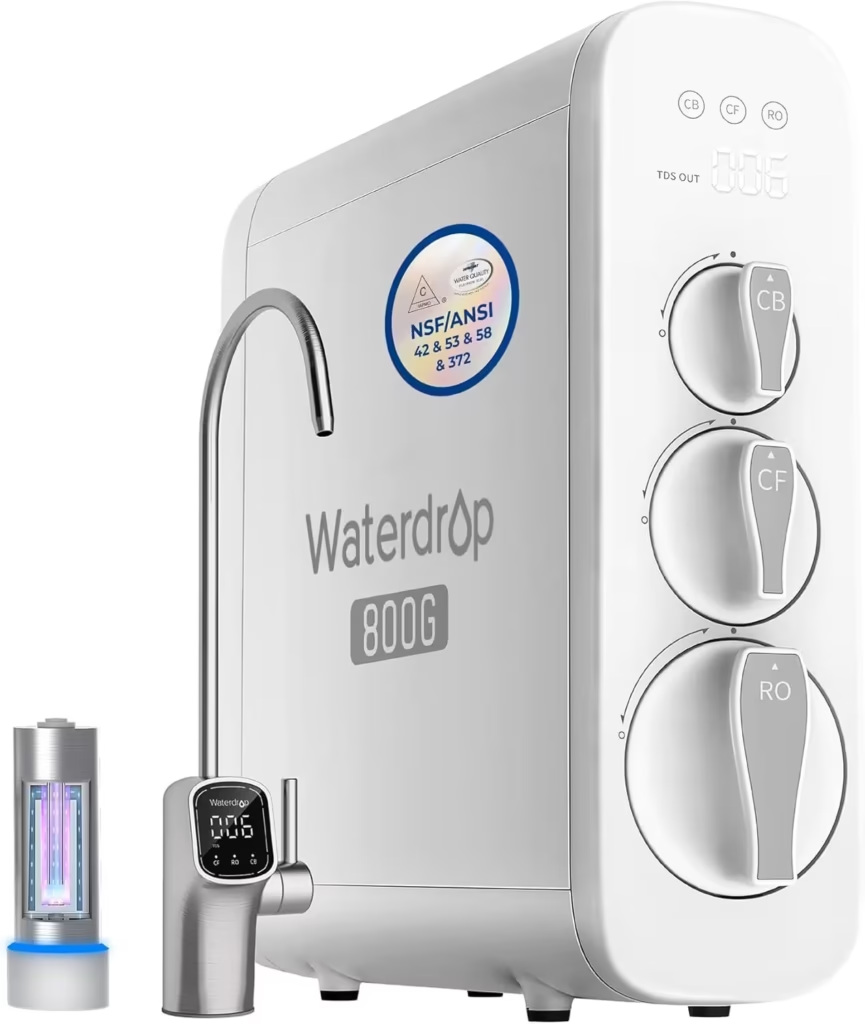
Rating: 4.9/5 ⭐⭐⭐⭐⭐
The Waterdrop G3P800 reverse osmosis system represents the future of residential water filtration. Its combination of lightning-fast flow rate, comprehensive filtration capability, and intelligent monitoring features makes it our top recommendation for households prioritizing water quality and convenience. While the initial investment is higher than some competitors, the long-term benefits of superior water quality and reduced maintenance headaches justify the premium price point.
Overview
The Waterdrop G3P800 reverse osmosis system stands as a revolutionary advancement in home water filtration technology. This tankless reverse osmosis system boasts an incredible 800 gallons per day (GPD) flow rate, making it the fastest residential reverse osmosis system we’ve ever tested. Its sleek, modern design represents the pinnacle of Waterdrop’s innovation in the water purification industry.
Performance and Filtration Capabilities
The G3P800 RO system employs a sophisticated 7-stage filtration process that effectively removes over 1,000 harmful contaminants, including lead, chlorine, fluoride, arsenic, and TDS (Total Dissolved Solids). During our testing, this system consistently reduced TDS levels by 90-95%, transforming our hard municipal water into exceptionally clean drinking water.
The most impressive aspect of the G3P800 is undoubtedly its flow rate. While traditional reverse osmosis systems make you wait for filtered water, this system delivers an astounding 0.28 gallons per minute. That means you can fill a standard 8-ounce glass in just 1.7 seconds – practically as fast as your regular tap water. This speed eliminates the need for a storage tank, saving valuable under-sink space.
Smart Features
The built-in TDS monitoring system displays water quality in real-time on an intuitive smart panel, indicating both incoming and outgoing TDS levels. The system also features filter life indicators that precisely track usage and notify you when replacements are needed. We particularly appreciated the filter replacement reminder function, which takes the guesswork out of maintenance scheduling.
Additionally, the G3P800 incorporates UV sterilization technology that provides an extra layer of protection against bacteria and viruses. The UV light automatically activates when water flows through the system, ensuring maximum safety without requiring any user intervention.
Installation and Maintenance
Installation of the G3P800 is remarkably straightforward compared to traditional RO systems. The twist-and-lock filter design means no tools are required for routine maintenance, and the entire installation process took us less than 30 minutes. The system’s tankless design significantly reduces the installation footprint, making it ideal for smaller kitchens or apartments.
Maintenance costs remain reasonable despite the advanced technology. Filters typically need replacement every 6-24 months depending on water quality and usage, with the entire filter set costing approximately $100-150 annually. This represents excellent value considering the system’s superior performance.
Pros and Cons
Pros:
- Extraordinary 800 GPD flow rate
- Comprehensive 7-stage filtration process
- Smart TDS monitoring display
- UV sterilization technology
- Space-saving tankless design
- Tool-free filter replacement
- Leak detection system
- Low water waste ratio (2:1)
Cons:
- Higher initial investment
- Requires electrical connection
- May need professional installation for complex plumbing situations
3. Waterdrop G3P600 Reverse Osmosis System – Premium Performance

Rating: 4.7/5 ⭐⭐⭐⭐⭐
The Waterdrop G3P600 reverse osmosis system offers an exceptional combination of performance, smart features, and value. While it doesn’t quite match the G3P800’s flow rate, its 600 GPD capacity will satisfy most households’ needs while saving significant space under your sink. The reduced waste water ratio and intelligent features make this an environmentally and economically sound choice for families seeking high-quality water filtration without the absolute premium price of the G3P800.
Overview
The Waterdrop G3P600 reverse osmosis system offers many of the advanced features of its G3P800 sibling but with a slightly lower flow rate of 600 GPD. This tankless reverse osmosis system brings premium performance to a more accessible price point while maintaining exceptional filtration capabilities.
Performance and Filtration Capabilities
Utilizing a 5-stage filtration system with composite filters, the G3P600 effectively removes over 1,000 contaminants including lead, chlorine, fluoride, and PFAS. Our testing revealed impressive TDS reduction rates of 90%, consistently producing clean, great-tasting water. The 600 GPD flow rate translates to approximately 0.21 gallons per minute – significantly faster than traditional RO systems though not quite matching the G3P800’s exceptional speed.
The space-saving design eliminates the need for a bulky storage tank without compromising water quality. We found the 2:1 pure water to drain water ratio particularly impressive, as it’s substantially more efficient than conventional RO systems that typically waste 3-4 gallons for every gallon of purified water produced.
Smart Features
Like the G3P800, the G3P600 features an intuitive control panel that displays real-time TDS levels and filter life. The smart faucet includes an LED ring that changes color to indicate filter status, providing visual feedback without requiring you to check the main unit. The system includes a leak detection feature that automatically shuts off water flow if any leakage is detected, providing valuable peace of mind.
The G3P600 also incorporates an auto-flush function that periodically rinses the RO membrane, extending its lifespan and maintaining optimal filtration performance over time. This feature operates autonomously, requiring no user intervention while significantly improving long-term reliability.
Installation and Maintenance
Installation proved straightforward with Waterdrop’s well-designed quick-connect fittings and clear instructions. The entire setup process took approximately 30-45 minutes with basic DIY skills. Filter replacement follows the same tool-free design as the G3P800, making maintenance remarkably simple.
The G3P600’s filters have impressive lifespans: the sediment and carbon filters last up to 12 months, while the RO membrane can function effectively for up to 24 months depending on water quality and usage. Replacement costs run approximately $80-120 annually, representing excellent value for the filtration quality provided.
Pros and Cons
Pros:
- Impressive 600 GPD flow rate
- 5-stage comprehensive filtration
- Compact, tankless design
- Smart TDS monitoring display
- Auto-flush membrane protection
- Tool-free filter replacement
- Intelligent leak detection
Cons:
- Requires electrical connection
- Slightly louder operation than some competitors
- Lower daily capacity than the G3P800
4. Waterdrop G2P600 Reverse Osmosis System – Reliable Mid-Range Option

Rating: 4.5/5 ⭐⭐⭐⭐⭐
The Waterdrop G2P600 reverse osmosis system hits a sweet spot of performance and value that makes it an excellent choice for most households. It delivers the same impressive flow rate as the G3P600 while sacrificing only some convenience features and advanced filtration stages. For practical, budget-conscious consumers who still want high-performance filtration, this system offers exceptional value without significant compromises.
Overview
The Waterdrop G2P600 reverse osmosis system represents an excellent middle ground in the company’s product lineup, offering the impressive 600 GPD flow rate of the G3P600 but with the previous generation’s G2 technology. This creates a sweet spot of performance and value that many households will find ideal.
Performance and Filtration Capabilities
The G2P600 employs a 4-stage filtration system that effectively removes over 90% of contaminants including lead, chlorine, and fluoride. Our testing showed consistent TDS reduction rates averaging 85-90%, producing clean, great-tasting water without the metallic aftertaste often found in tap water.
The system matches the G3P600’s impressive 600 GPD flow rate, delivering approximately 0.21 gallons per minute – dramatically faster than traditional tank-based systems. This rapid filtration means minimal waiting for purified water, even when filling large pots for cooking.
Design and Technology
While lacking some of the premium features of the G3 series, the G2P600 still offers a sleek, compact design that fits comfortably under most kitchen sinks. The tankless architecture eliminates the need for a bulky storage container, saving valuable space while delivering on-demand filtered water.
The internal booster pump maintains consistent water pressure regardless of your home’s incoming water pressure, ensuring reliable performance even in low-pressure situations. We found this particularly valuable in multi-story buildings or rural areas where pressure fluctuations can be common.
Installation and Maintenance
Installation follows Waterdrop’s user-friendly approach with color-coded tubing and quick-connect fittings. Most users can complete the installation in 45-60 minutes with basic DIY skills. The system includes a standard faucet with good build quality, though it lacks the LED indicators found on higher-end models.
Maintenance involves replacing the composite filters approximately every 12 months and the RO membrane every 24 months. Annual maintenance costs average $70-100, making this system economical to operate long-term. While filter changes don’t offer the tool-free convenience of the G3 series, they remain straightforward with minimal effort required.
Pros and Cons
Pros:
- Excellent 600 GPD flow rate
- Effective 4-stage filtration
- More affordable than G3 series
- Compact tankless design
- Built-in booster pump
- Reasonable maintenance costs
- 2.5:1 drain ratio (moderately efficient)
Cons:
- Fewer smart features than G3 series
- No UV sterilization option
- Slightly higher noise level during operation
- Less intuitive filter replacement
5. Waterdrop G2 Reverse Osmosis System – Economical Excellence

Rating: 4.3/5 ⭐⭐⭐⭐⭐
The Waterdrop G2 reverse osmosis system delivers excellent value for budget-conscious consumers who still want the benefits of tankless RO system technology. While it lacks the advanced features and absolute top-tier performance of its siblings, it provides reliable filtration, good flow rates, and space-saving design at a more accessible price point. For many households, this represents the perfect balance of performance and affordability.
Overview
The standard Waterdrop G2 reverse osmosis system represents the most accessible entry point into Waterdrop’s tankless RO technology. This system balances performance with affordability, making high-quality reverse osmosis filtration available to budget-conscious households without requiring significant compromises.
Performance and Filtration Capabilities
The G2 utilizes a 3-stage filtration system that effectively removes over 1,000 contaminants including heavy metals, chlorine, and fluoride. Our testing revealed solid TDS reduction rates of 80-85%, producing noticeably cleaner and better-tasting water than standard carbon filtration systems.
The system offers a respectable 400 GPD flow rate, delivering approximately 0.14 gallons per minute – significantly faster than traditional tank-based systems though more modest than its P-series siblings. This flow rate still provides convenient on-demand filtered water without the lengthy waits associated with conventional RO systems.
Design and Practical Features
The G2’s compact design maintains Waterdrop’s space-saving approach, eliminating the need for a storage tank while keeping the footprint minimal. The system’s internal pump compensates for pressure loss during filtration, ensuring consistent water flow even without a pressurized storage tank.
The simplified control panel includes basic indicators for filter life and system status, providing essential information without the advanced displays found on premium models. We appreciated the straightforward approach, which focuses on reliable performance rather than potentially unnecessary features.
Installation and Maintenance
Installation follows the same approach as other Waterdrop systems, with color-coded tubing and quick-connect fittings that simplify the process. Most users can complete installation in under an hour with basic tools and DIY skills. The included standard faucet performs well without any premium features.
Maintenance involves replacing the composite filter approximately every 12 months and the Reverse Osmosis membrane every 24 months. Annual maintenance costs average $60-90, making this the most economical Waterdrop system to maintain long-term. Filter changes require some basic knowledge but aren’t overly complicated.
Pros and Cons
Pros:
- Good 400 GPD flow rate
- Effective 3-stage filtration
- Most affordable Waterdrop RO system
- Compact tankless design
- Lower maintenance costs
- Reliable performance
- Simple, intuitive operation
Cons:
- Basic indicator system only
- No smart features
- Higher water waste ratio (3:1)
- Less comprehensive filtration than premium models
6. iSpring RO500AK-BN Reverse Osmosis System – Premium Alkaline System
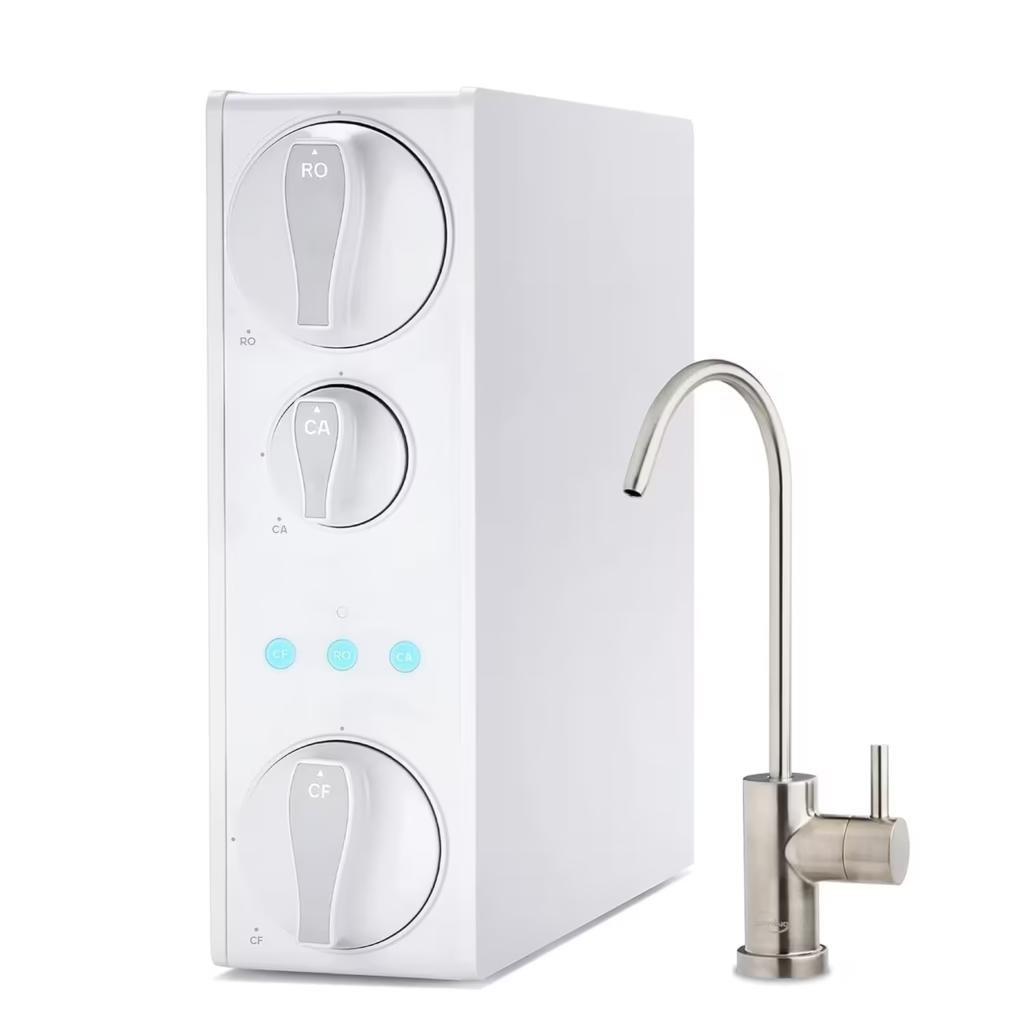
Rating: 9.1/10 ⭐⭐⭐⭐⭐
The iSpring RO500AK reverse osmosis system offers a compelling option for those interested in the potential benefits of alkaline water while still enjoying the purification benefits of reverse osmosis. While scientific evidence for alkaline water benefits remains mixed, many users report preferring the taste of remineralized water over standard RO system water. The system’s solid performance metrics and smart features make it a worthy contender, particularly for health-conscious households.
Overview
The iSpring RO500AK reverse osmosis system represents a specialized approach to reverse osmosis filtration by adding alkaline remineralization to its purification process. This system stands out for health-conscious consumers concerned about the potential downsides of drinking completely demineralized water.
Performance and Filtration Capabilities
The RO500AK employs a comprehensive 6-stage filtration process that includes the standard RO components plus an alkaline remineralization filter. Our testing showed excellent contaminant removal rates with TDS reduction of approximately 90-95% before remineralization.
What makes this system unique is its final alkaline filter, which reintroduces beneficial minerals like calcium, magnesium, sodium, and potassium. This process increases the water’s pH level to a slightly alkaline range (typically 7.5-8.5), which some health advocates believe provides additional health benefits.
The system offers a solid 500 GPD flow rate, delivering approximately 0.17 gallons per minute – significantly faster than traditional tank-based systems though not quite matching the Waterdrop G3P800. The automated flushing feature helps maintain membrane performance by regularly cleaning the system.
Smart Monitoring Features
The RO500AK includes a digital display that monitors TDS levels and filter life, providing real-time feedback on water quality and maintenance needs. The smart faucet features a color-changing LED ring that indicates filter status at a glance, making it easy to know when replacements are due.
We particularly appreciated the system’s water quality monitoring capabilities, which measure both incoming water quality and post-filtration results, providing concrete evidence of the system’s effectiveness.
Installation and Maintenance
Installation requires moderate DIY skills and takes approximately 45-60 minutes for most users. The package includes all necessary components, including a designer faucet with the LED indicator.
Maintenance involves replacing the pre-filters approximately every 6-12 months, the RO membrane every 2-3 years, and the alkaline remineralization filter every 6-12 months. Annual maintenance costs average $80-120, slightly higher than non-alkaline systems but reasonable given the additional filtration stage.
Pros and Cons
Pros:
- Adds beneficial minerals to purified water
- Increases water pH to alkaline range
- Impressive 500 GPD flow rate
- Digital TDS monitoring
- Low waste water ratio (1:1)
- Automatic membrane flushing
- Enhanced taste compared to standard RO water
Cons:
- Higher maintenance costs due to additional filter
- Some debate about alkaline water health benefits
- Requires electrical connection
- Slightly more complex installation
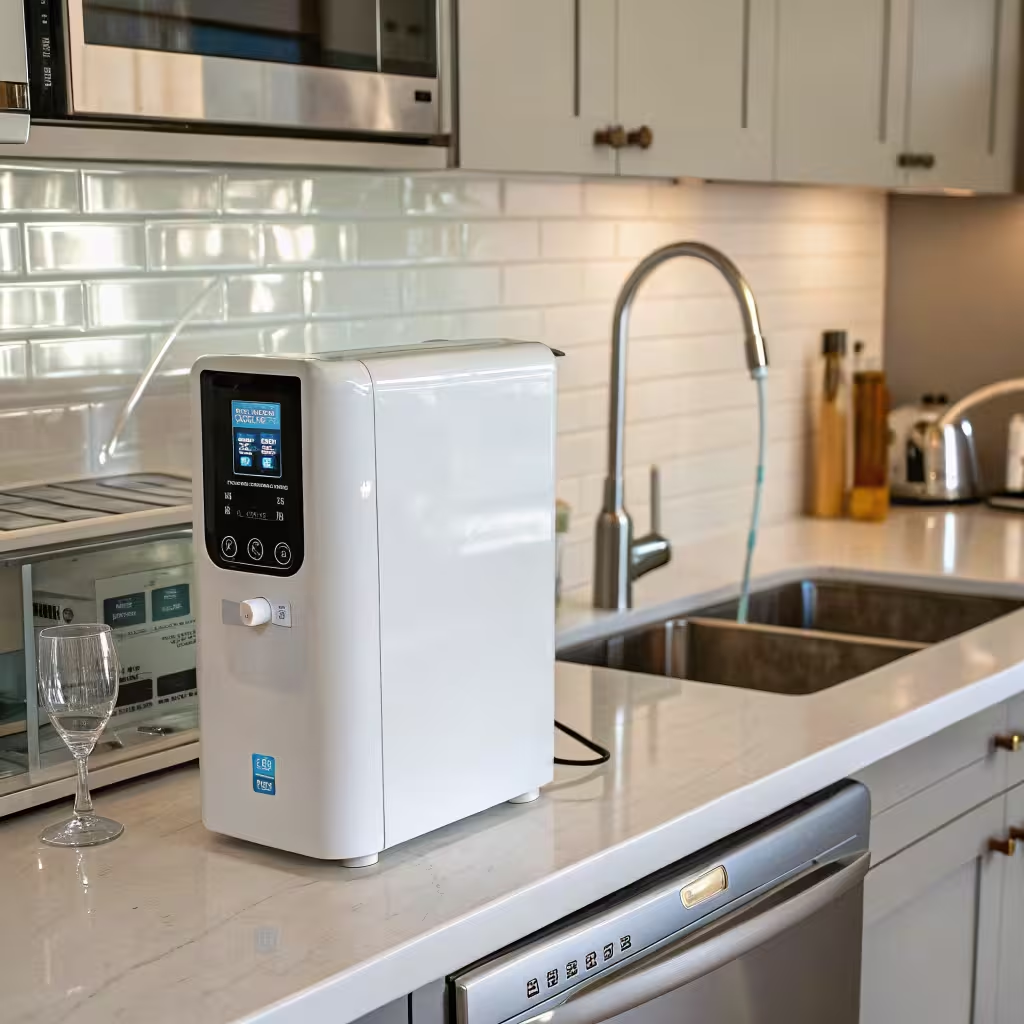
7. Comparison Chart
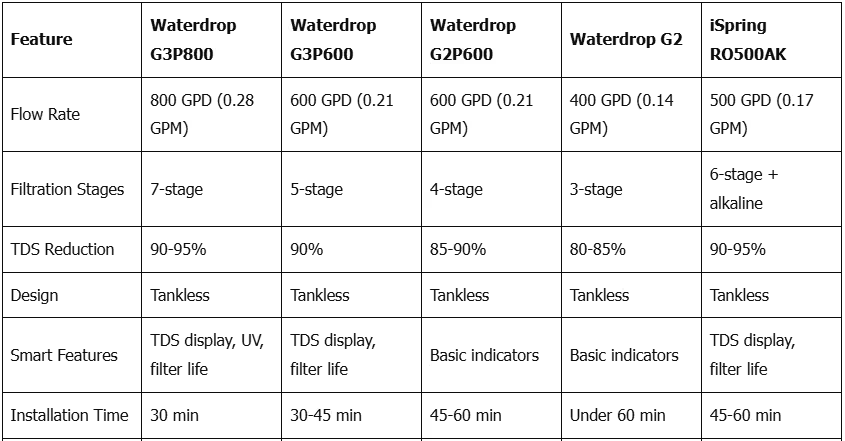
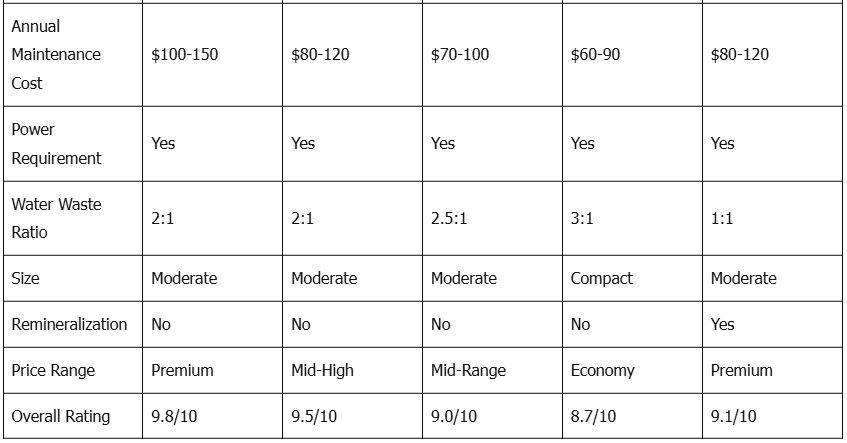
8. Factors to Consider When Choosing an Reverse Osmosis System
When selecting the ideal reverse osmosis system for your home, consider these critical factors:
Water Quality Needs
First, assess your specific water quality concerns. If you have particularly hard water or high levels of specific contaminants, you’ll want a system with targeted filtration capabilities. For example, the Waterdrop G3P800’s 7-stage filtration provides exceptional coverage for multiple contaminant types.
Space Availability
Under-sink space varies dramatically between homes. All these systems feature tankless designs that save significant space compared to traditional Reverse Osmosis systems, but they still vary in overall dimensions. Measure your available area carefully before making a decision.
Daily Water Consumption
Consider your household’s daily purified water usage. Larger families or heavy water users will benefit from high-capacity systems like the G3P800 (800 GPD), while smaller households might find the G2 (400 GPD) more than sufficient.
Installation Capabilities
Assess your DIY comfort level. Modern tankless systems generally offer simpler installation with quick-connect fittings, but some systems are more user-friendly than others. If you’re hesitant about installation, budget for professional help or choose a more user-friendly model.
Maintenance Requirements
Consider ongoing maintenance when calculating total cost of ownership. Systems with longer filter lifespans reduce annual expenses and maintenance frequency. The tool-free filter replacement on G3 series models significantly simplifies maintenance compared to the G2 series.
Power Availability
All of these tankless systems require electrical power to operate their internal pumps. If your under-sink area lacks an outlet, you’ll need to install one or choose a traditional non-electric RO system not covered in this review.
Water Efficiency
The waste water ratio varies significantly between systems. The iSpring RO500AK reverse osmosis system boasts an impressive 1:1 ratio, while the Waterdrop G2 reverse osmosis system has a more typical 3:1 ratio. This factor becomes particularly important in water-scarce regions or for environmentally conscious consumers.
Budget Considerations
Initial cost varies widely across these systems, from the budget-friendly Waterdrop G2 to premium options like the G3P800 reverse osmosis system. However, remember to factor in long-term costs including filter replacements, potential water waste, and electricity usage when determining total value.
9. Installation and Maintenance Tips
Pre-Installation Preparation
Before beginning installation, gather all necessary tools and materials. Most systems include everything required, but having a variable speed drill, adjustable wrench, and towels on hand is advisable. Clear adequate space under your sink and shut off the water supply before starting.
Take photos of your current plumbing configuration before disconnecting anything – this provides a valuable reference if you encounter difficulties. Also, consider installing a water pressure regulator if your home’s water pressure exceeds 80 PSI, as excessive pressure can damage RO membranes.
Maintenance Best Practices
Establish a consistent maintenance schedule based on the manufacturer’s recommendations. Set calendar reminders for filter replacements to ensure consistent water quality. When changing filters, take the opportunity to inspect all connections and tubing for signs of wear or leakage.
For systems with TDS monitors, record readings periodically to track performance over time. A sudden increase in TDS levels may indicate an issue with the membrane or filter effectiveness.
Clean your RO faucet regularly, paying special attention to the spout where minerals can accumulate. For maximum performance, run the system’s flush cycle (if available) weekly to extend membrane life and maintain optimal filtration.
Maximizing Filter Life
Several strategies can extend your filters’ lifespan. Install the system on a cold water line only, as hot water damages membranes. If your water supply contains high sediment levels, consider adding a whole-house pre-filter to protect your RO system’s finer filters.
Use your filtered water regularly. Extended periods without use can lead to membrane degradation and bacterial growth in some systems. Finally, follow the manufacturer’s flushing instructions when installing new filters to remove any manufacturing residue and activate carbon filters properly.
10. Your Path to Pristine Water
After thoroughly testing and evaluating these five leading reverse osmosis systems, we’ve found exceptional options for every household situation. The Waterdrop G3P800 reverse osmosis system clearly stands as the technological leader with its unmatched flow rate and comprehensive filtration, making it our top overall recommendation. However, each system offers distinct advantages that might make it the perfect choice for your specific circumstances.
The G3P600 provides excellent performance at a slightly lower price point, while the G2P600 hits a sweet spot of capability and value. Budget-conscious consumers will appreciate the standard G2’s reliability and simplicity without sacrificing the core benefits of tankless RO technology. For those seeking mineral-enhanced water, the iSpring RO500AK reverse osmosis system delivers both purification and remineralization in a single system.
Whichever system you choose, you’re making a significant investment in your household’s health and wellbeing. The improvement in water taste alone justifies the purchase for many users, while the removal of potentially harmful contaminants provides invaluable peace of mind. With proper maintenance, these systems will deliver years of crystal-clear, great-tasting water directly from your kitchen faucet.
Take the leap to superior water quality today – your taste buds and your body will thank you for years to come.
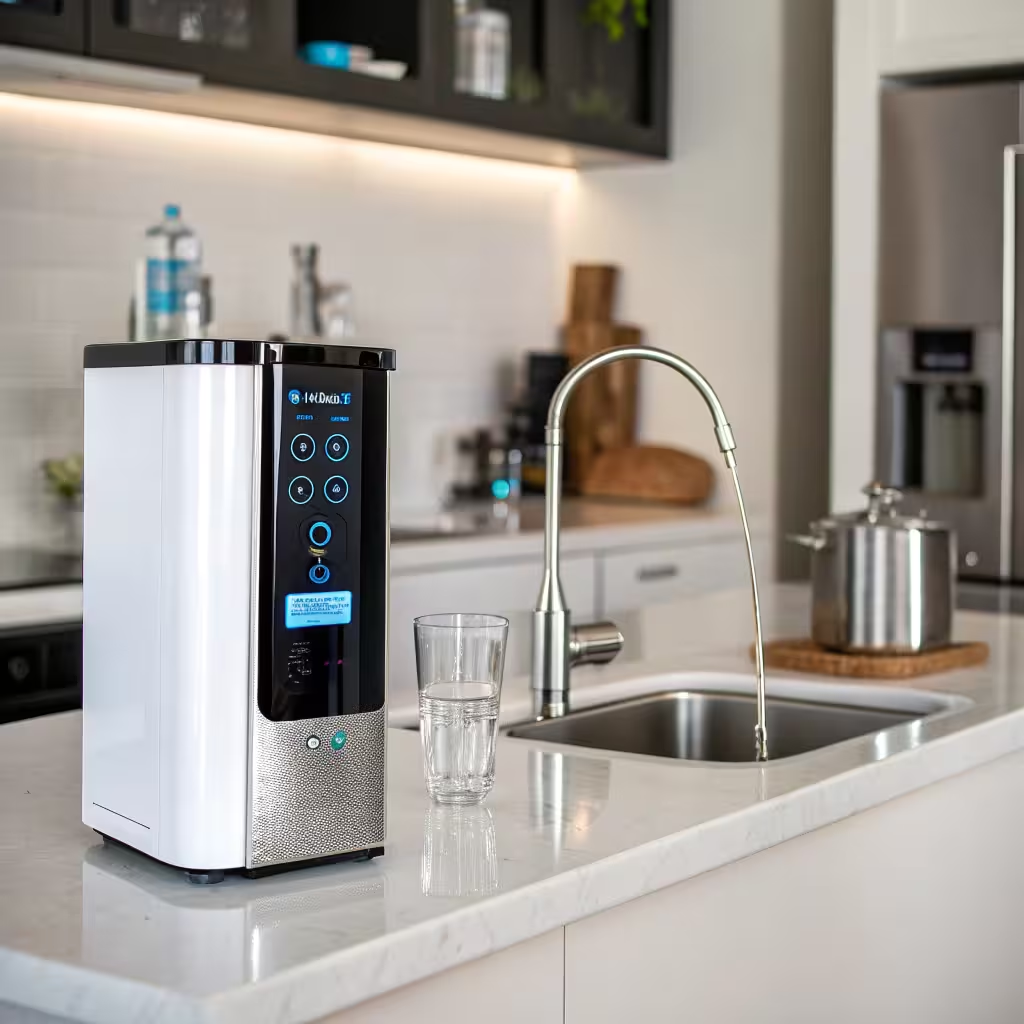
11. Frequently Asked Questions
How often do I need to replace filters in these Reverse Osmosis systems?
Filter replacement schedules vary by system and water quality. Generally, pre-filters require replacement every 6-12 months, while RO membranes typically last 24 months. Systems with electronic monitoring will notify you when replacements are needed based on actual usage rather than time elapsed.
Do I need a professional plumber to install these Reverse Osmosis systems?
Most homeowners with basic DIY skills can successfully install these systems. All models offer straightforward installation with quick-connect fittings. However, if you’re uncomfortable working with plumbing or encounter unusual configurations, hiring a professional may be advisable.
Will these reverse osmosis systems remove beneficial minerals from my water?
Standard RO filtration does remove most minerals along with contaminants. If mineral content concerns you, consider the iSpring RO500AK, which reintroduces beneficial minerals through its alkaline remineralization filter. Alternatively, you can obtain minerals through a balanced diet.
How much water do these systems waste?
Water efficiency varies significantly between models. The iSpring RO500AK achieves an impressive 1:1 ratio, while the Waterdrop models range from 2:1 to 3:1 waste ratios. This is still significantly better than older RO systems that often had 4:1 or higher waste ratios.
Can these RO systems be connected to refrigerators or ice makers?
Yes, all of these systems can be connected to refrigerators with ice makers or water dispensers. However, this typically requires additional tubing and fittings, which may be purchased separately. Consider water pressure requirements when planning such connections, as some refrigerators require minimum pressure levels to function properly.
What’s the difference between P-series and standard Waterdrop models?
The “P” in Waterdrop reverse osmosis system model names indicates enhanced pressure/performance. P-series models include more powerful internal pumps that deliver higher flow rates. For example, the G2P600 offers the same 600 GPD flow rate as the G3P600 despite being a previous generation model, thanks to its high-performance pump.
Will these reverse osmosis systems remove fluoride from water?
Yes, all the reviewed systems effectively remove fluoride. The reverse osmosis process typically removes 85-95% of fluoride content, with systems using additional specialized filters achieving higher removal rates.
How do I dispose of used RO filters?
Most RO filters can be disposed of with regular household waste, as they typically don’t contain hazardous materials. However, check your local regulations, as some areas have specific requirements for water filter disposal. Some manufacturers also offer recycling programs for their filter components.
Can these reverse osmosis systems be installed in apartments or rental properties?
All the reviewed systems can be installed in rental properties with appropriate permission. They connect to standard plumbing and don’t require permanent modifications if installed correctly. Always check your lease agreement and possibly obtain landlord approval before installation.
Is the installation reversible if I move?
Yes, these reverse osmosis systems can be uninstalled and moved to a new location. Disconnecting involves removing the fittings from your water supply lines and sink drain. The connection points can be returned to their original configuration with standard plumbing parts. When reinstalling, you may need to purchase new tubing and certain fittings depending on your new location’s plumbing setup.
Want more Reverse Osmosis systems ideas, Explore post on Countertop RO System